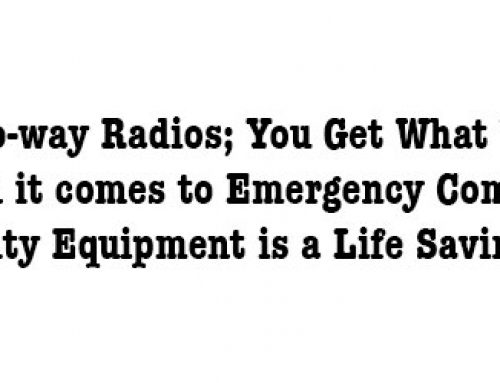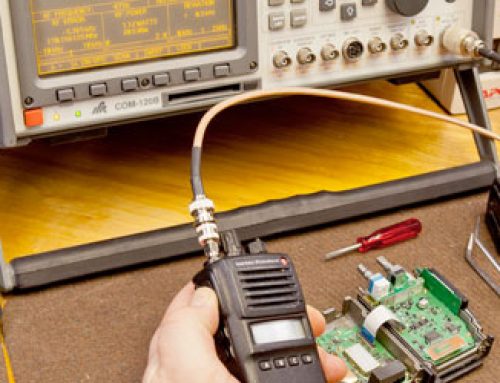Understand how repeaters work, when you need one, what to expect in the buying process, and selecting the right vendor for the job.
This article is written with the non-technical person in mind, we will do our best to explain things in layman terms. First, we should explain what a two-way radio repeater is. All too often repeaters are explained in very confusing technical terms. We will walk you through a process so you will get a better understanding of how a repeater can work, its limitations, and what is needed to implement repeater(s) into your current two-way radio system.
In this article, we will be discussing a conventional type repeater, which means only one talk path at a time or one person at a time can access the repeater. Conventional repeaters can accommodate multiple radio channels, by using different PL tones, NAC codes, or color codes but this is beyond the scope of this article. Just know that depending on your goals for the radio system a repeater system can service many radio channels. Sometimes when talking about repeaters the term “trunking” may come up, trunking is beyond the scope of this article but know it’s a type of repeater. Radio trunking will be addressed in another article.
A two-way radio repeater is a special type of radio that hears a specific weak radio signal and then rebroadcasts that weak signal stronger on another frequency where your radios are listening. We will explain why it gets rebroadcast to another frequency later in this article.
Repeaters are used to increase the radio signal strength and coverage area in a given application, hence improving the two-way radio calling area.
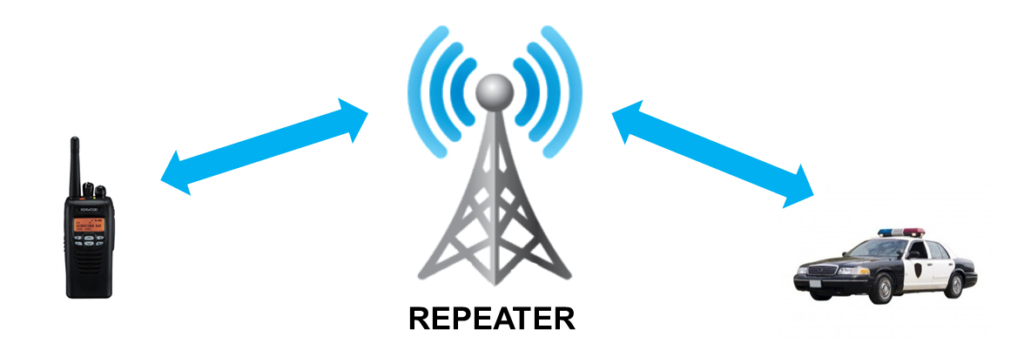
This simple graphic above shows a two-way radio call from a 5-watt portable radio going through the repeater, to a 50 Watt mobile radio inside a vehicle than back to the repeater. Extending the range of all radios on the system.
Below are a few simple examples where a repeater may be needed:
- A large warehouse using radio simplex operations, radio to radio, or talk around the channel, is not getting the job done. Typically the customer will complain about gaps in radio coverage or dead spots.
- A business that needs to company communication campus-wide across many buildings and inside and outside these buildings.
- A school district where the Board of Education wants to be able to talk to all their schools on a given radio channel.
- A bus company that needs to communicate county-wide to its drivers
- A Police or Fire Department that needs to communicate city-wide.
Two-way radio repeaters work in a unique way.
They use two frequencies to operate, one frequency is for listening or receiving and the other frequency is for broadcasting or transmitting. The radios that are accessing the repeater are programmed in the reverse of how the repeater is operating. A portable radio’s (walkie-talkie) receive frequency for the repeater is actually the repeater’s transmit frequency and the portable radio’s (walkie-talkie) transmit frequency is the repeater’s receive frequency. Stay with us I know this can be confusing.
To sum how a repeater operates a radio on the system wants to call another user and access the repeater system. The radio that is calling has to transmit (talk) on the frequency that the repeater is listening too. The repeater hears that call and rebroadcasts it stronger, then that same radio who started the conversation will want to hear the call back from the user they just called on the repeater. To hear this return call the radio has to be tuned to the transmit frequency (talk) of the repeater.
We recommend working with a qualified two-way radio dealer when programming radios to work on repeater systems, and in setting up a repeater system. If done incorrectly you can interfere with other licensed radio users and be to subject to fines.
Factors in a repeaters power and coverage on a radio system:
Working with customers we get asked all the time, “will this repeater cover every area we need and how much power can we transmit?” There are many different factors that can contribute to the repeater’s transmitter power strength and coverage on a system.
- Your current FCC license, and it limitations. Typically your current FCC license will need to be modified for repeater operations and there are transmit power limits depending on the frequency band of operation. The FCC license for the repeater’s frequencies will be coordinated based on the radio coverage area needed and the other surrounding FCC licensee’s coverage and power outputs. Think of frequencies as highway space, there are limited lanes open and speed limits.
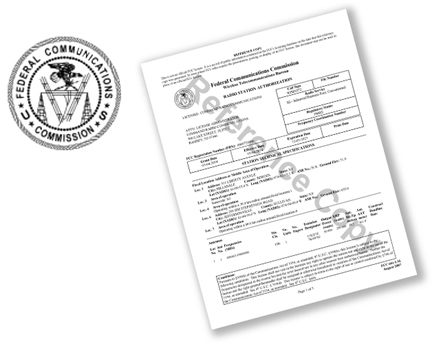
An FCC license is mandatory for repeater operations or you risk very steep fines.
- The power of your repeater’s transmitter – There are limits
- The frequency band in which the repeater is operating
- Some radio bands are great for in-building coverage where other bands are great for distance
- The type of antenna used
- Antennas are designed for specific applications, and not all antennas are created equal
- The type of RF cabling used, the thicker the RF cable used the less power loss in the application
- The distance between the transmitter and the antenna, the longer the cable run the more power loss in the application
- The emissions type, mode, the repeater is transmitting.
- Analog Wide – In the USA and depending on the frequency band you are operating on, in general, wideband operations are no longer allowed.
- Analog narrow – When some of our customers went to narrowband operation after the FCC mandate in 2013 they saw a reduction in radio coverage, because of the signal narrowing.
- Digital – In our testing we have seen a 20 to 30% boost in radio coverage when operating in the digital mode.
- Quality of the equipment used, make sure the equipment being specified in your repeater system has a track record. Ask for customer referrals. Depending on your project goals most effective repeater systems are not cheap, but if you use quality components and good design they can last 10 to 12 years.
- Quality of the equipment installation, in the past 26 years we have seen some poorly installed repeater systems which caused those systems to perform badly. Also because of the bad installation, they become a hazard to those near the system due to tripping hazards of unbuttoned up cable runs, equipment not installed in a rack or cabinet, lack of lightning protection, and proper grounding. Antennas installed improperly that were crooked or barely attached because of bad mounting procedures. One time we saw a repeater installed, placed, on two Styrofoam inserts that came from the box the repeater was shipped in, and if you bumped into it the whole system went down. This repeater was for security of a major hospital. When working with a new radio dealer ask for photos of their past installation work, a picture is worth a thousand words. Also, make sure the dealer you are working with has the correct insurances encase there is unforeseen damage during installation or if anyone is injured during the installation. Properly liability and workmen compensation insurance.
Basic components in a two-way radio repeater system:
Repeater systems can come in many shapes, sizes, and radio brands.
All simple conventional repeater systems have the same 7 to 9 basic components to make them work:

- The RF deck or repeater, this is the actual radio piece
- The power supply this electrically powers the RF Deck of the repeater system, sometimes these are built into the RF deck.
- The duplexer, this enables the repeater system to use one antenna for both transmit and receive functions. Quality duplexers also provide for extra filtering which helps in preventing interference and noise on the system.If duplexer is not part of the system then two antennas will have to be used. This is not an effective way of setting up a permanent solution because there can be issues locating two antenna locations at the same location with the correct separation between the antennas.
- The antenna is one of the most important parts of the system and you get what you pay for. Antennas are also designed in different ways to achieve different goals which is beyond the scope of this article.
- The RF (radio frequency) cabling, is used to connect the repeater to the antenna system. The design of the system will determine the length of the cable run and its thickness.
- Equipment cabinet or rack – this is used to house the system and keep it safe
- Grounding and lightning strike protection, if your system is not properly grounded it will not work correctly and proper lightning protection with protect the RF equipment inside the cabinet or on the equipment rack. Think of lightning protection as a fuse that will work to stop the lightning from getting to the RF gear if your antenna takes a strike.
- Optional components:
- Power amplifier – This is used to extract a low transmit power signal out of the repeater and amplify it to specific power output. The reason these are sometimes used is that some repeaters are not rated for continuous duty at a high power output let’s say 50 watts of transmit power, but can transmit all day long at 5 watts. Using a power amplifier we are able to take that 5-watt signal and transmit at 50 watts all day long and not damage the repeater in the long term.
- Intermodulation Panel – in simple terms this is an added filter to block interference from surrounding radio transmitters. These are used in highly populated areas where there are lots of similar radio band use.
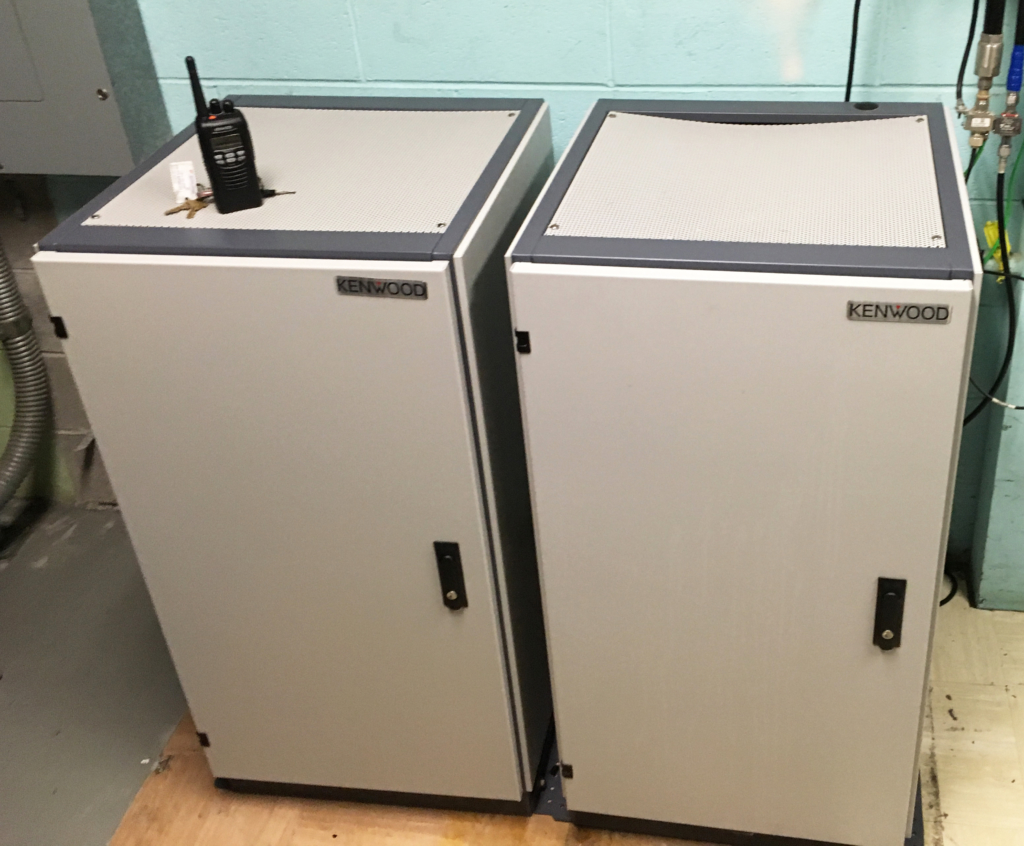
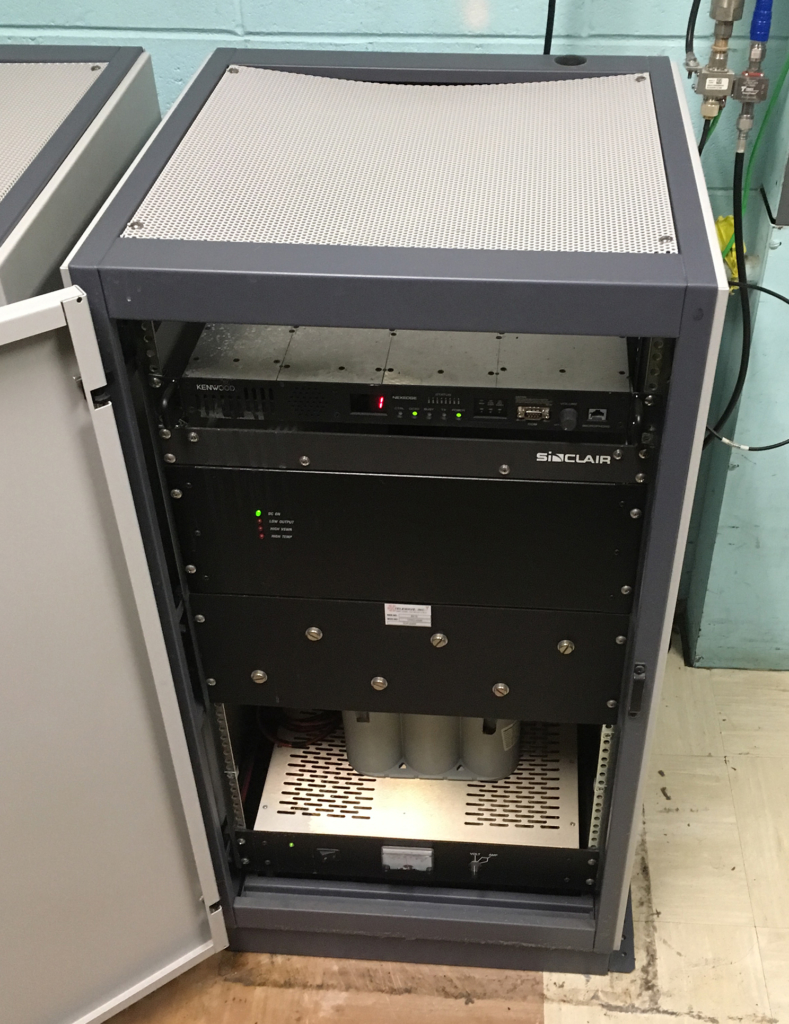
Depending on your project’s complexity you should expect the following when working with a good two-way radio dealer:
- A detailed proposal outlining the equipment they will be using, how and where it will be installed, pricing, warranty information, and after the sale service.
- FCC licensing, either getting you a new license or modifying your existing license
- If possible, radio coverage studies, even though they are theoretical it’s a great starting point to see if there are gaps in radio coverage
- If possible, live radio repeater testing to emulate the radio coverage you can expect
When you work with Command Radio Communications Inc., our approach to repeater systems is to prove out the system before you spend dollar one. We have a proprietary process in specifying a new repeater system based on how you want the system to work.
This way you have confidence in your new system before you buy. We also use this proprietary process in implementing the system, right down to the individual radio that will be communicating with the repeater.
We hope this information was helpful in explaining what a radio two-way repeater is, a basic understanding on how they are used, and the components that make up a system. If you are interested in looking at a repeater system we would recommend working with an experienced two-way radio dealer.
We would love to work with you to solve your communication goals if you fill out the simple form below one of our radio consultants will get back to you within 24 hours. Also we welcome your questions and look forward to working with you.
Have questions regarding this article or need help with two-way radios?
We would love to hear from you.
Please fill out the form below, and someone from our staff will contact you.


